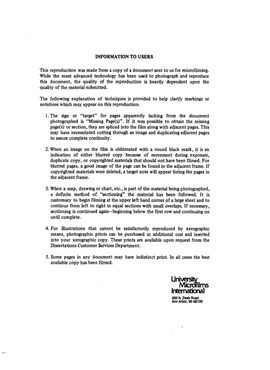| dc.contributor.author | Webber, Larry Dean, | en_US |
| dc.date.accessioned | 2013-08-16T12:29:00Z | |
| dc.date.available | 2013-08-16T12:29:00Z | |
| dc.date.issued | 1983 | en_US |
| dc.identifier.uri | https://hdl.handle.net/11244/5195 | |
| dc.description.abstract | The working use of the model was illustrated by reviewing the recent closure of two schools in Tulsa, Oklahoma, where the model was applied. | en_US |
| dc.description.abstract | The purpose of this study was to develop a model for closing schools in large metropolitan school districts faced with declining enrollments. Included in this case study was a review of the existing literature on declining enrollment and school closure and a detailed review of consolidation efforts in three cities: (1) Seattle, Washington, (2) Salt Lake City, Utah, (3) Tulsa, Oklahoma. | en_US |
| dc.description.abstract | Recommendations that emerged from the study that appear to have relevance for large urban school systems facing school closure because of declining enrollment included: (1) A district should have a rational consolidation plan. (2) Early planning is crucial. (3) There must be community involvement. (4) Community acceptance is a necessary prior condition. . . . (Author's abstract exceeds stipulated maximum length. Discontinued here with permission of author.) UMI | en_US |
| dc.description.abstract | The data for the study were collected over an extended period of time and the researcher was a participant-observer in one of the selected school systems. The data were collected by the use of three data gathering techniques: (1) a search of available written materials, (2) direct observation, and (3) interviews. The data were analyzed and used as a basis for the development of a model for schools in declining enrollment districts. | en_US |
| dc.description.abstract | As a result of the study, criteria emerged which were used as a part of the school closing model. They included: (1) Early planning, (2) Community involvement, (3) Lead time, (4) Flexibility, and (5) Communication. The four components of the model were: (1) Data gathering--data collected include school facilities studies, enrollment statistics, financial situation of district, minimum and maximum size of schools, criteria for school closing, impact on education programs, desegregation, transportation and community; (2) Community education--informing the community of problems faced by the district; (3) Organization--the organization of area planning councils; (4) Decision making--the interaction of the school planning councils, area planning councils, superintendents staff and the school board as they seek a decision on school closings. The functions and relationships of the components of the model were discussed and graphically illustrated. | en_US |
| dc.format.extent | vi, 104 leaves : | en_US |
| dc.subject | Education, Administration. | en_US |
| dc.title | A case study of closing schools in a large metropolitan school district experiencing declining enrollment / | en_US |
| dc.type | Thesis | en_US |
| dc.thesis.degree | Educat.D. | en_US |
| dc.thesis.degreeDiscipline | Jeannine Rainbolt College of Education | en_US |
| dc.note | Source: Dissertation Abstracts International, Volume: 45-01, Section: A, page: 0048. | en_US |
| ou.identifier | (UMI)AAI8404563 | en_US |
| ou.group | Jeannine Rainbolt College of Education | |
